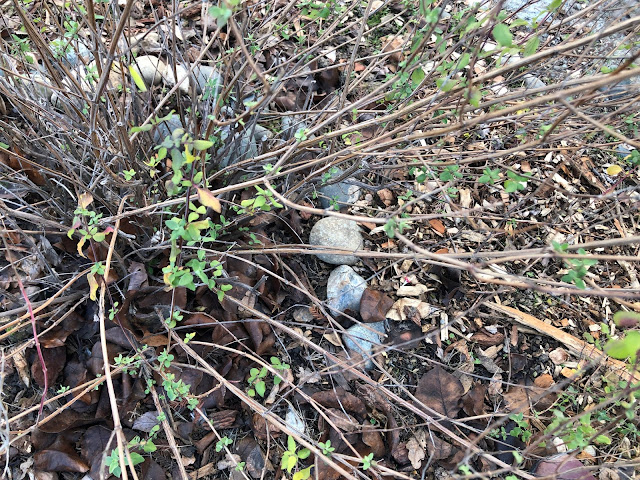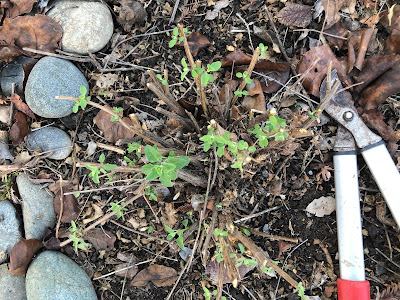

|
| Look how leggy this “Hot Lips” salvia has become, even though it’s in a warm spot with plenty of sun. Time to prune it back. (Photos: Kathy Morrison) |
Pity the blooming perennial. Once in the ground, it’s considered so reliable that it’s essentially ignored. The gardener gets busy planting annuals, seeding vegetables and spraying fruit trees. The needy bloomers, such as roses, get attention, too.
Meanwhile the salvia pushes out flowers, attracting bees and other pollinators. This goes on for years, perhaps, until the gardener happens to focus on it. “Wow, that plant has really gotten leggy, and doesn’t bloom as much.” So the perennial is pulled out, tossed in the green waste bin, and the cycle starts over.
It doesn’t have to be that way. And the answer is simple: Whack it back during the winter.
Many other perennials take care of themselves by dying back to the ground in the winter. My coneflowers always freak me out a little when they do this; they always return.

|
|
Here’s the same salvia after lopper pruning. I then took my pruning
shears, with some finer control, to the dead stubs at the base. |
Quentyn Young, manager of Fair Oaks Boulevard Nursery and a master gardener, gave a great Zoom presentation on pruning woody shrubs at a recent online meeting of the Sacramento County master gardeners.
Here’s his list of popular woody perennials that can and should be pruned hard now:
— Abutilon. This beauties can get quite leggy, he says.
— Buddleia (butterfly bush). These can grow 4 feet in a year, so cut to the ground or at least to 2 feet tall.
— Callicarpa (beautyberry).
— Summersweet ( Clethra alnifolia).
— Caryopteris (bluebeard).
— Cotinus (smokebush).
— Crape myrtle. These ubiquitous bushes/trees bloom much better on new wood, Young says.
— Ornamental elderberry.
— Chaste tree ( Vitex agnus castus) Remove one-third to one-half of the bush.
— Mock orange (Philadelphus virginalis).
— Nandina (heavenly bamboo).
— Podocarpus (fern pine).
— Sages (salvia), including pineapple sage. They can go almost to the ground.
Important to note: Anything flowering now or due to bloom in spring should not be pruned until after bloom. These plants include camellias, lilacs, loropetalum, winter daphne, witch hazel and flowering quince.
Evergreen “foundation” plants can also benefit from winter pruning or at least shaping, Young noted. This group includes photinia, escallonia, pittosporum and euonymous. Woody herbs such as lavender also should be reshaped in winter.
The Sacramento master gardeners filmed a helpful video about pruning woody sages for Harvest Day last summer. It addresses both summer and winter pruning. Check it out here: https://youtu.be/-SZIpyaGc0o
Kathy Morrison Hellesen is a newly minted Sacramento County master gardener.
Comments
0 comments have been posted.Sacramento Digs Gardening to your inbox.
Sites We Like
Garden Checklist for week of May 12
Get your gardening chores and irrigation done early in the day before temperatures rise.
* Plant, plant, plant! It’s prime planting season in the Sacramento area. Time to set out those tomato transplants along with peppers and eggplants. Pinch off any flowers on new transplants to make them concentrate on establishing roots instead of setting premature fruit.
* Direct-seed melons, cucumbers, summer squash, corn, radishes, pumpkins and annual herbs such as basil.
* Harvest cabbage, lettuce, peas and green onions. This heat will cause leafy greens and onions to flower; pick them before they bolt.
* In the flower garden, direct-seed sunflowers, cosmos, salvia, zinnias, marigolds, celosia and asters.
* Plant dahlia tubers. Other perennials to set out include verbena, coreopsis, coneflower and astilbe.
* Transplant petunias, marigolds and perennial flowers such as astilbe, columbine, coneflowers, coreopsis, dahlias, rudbeckia and verbena.
* Keep an eye out for slugs, snails, earwigs and aphids that want to dine on tender new growth.
* Feed summer bloomers with a balanced fertilizer.
* For continued bloom, cut off spent flowers on roses as well as other flowering plants.
* Got fruit trees? If you haven't already done so, thin orchard fruit such as apples, peaches, pears, pluots and plums before they grow too heavy, breaking branches or even splitting the tree. Leave the largest fruit on the branch, culling the smaller ones, and allow for 5 to 6 inches (or a hand's worth) between each fruit.
* Thin grape bunches, again leaving about 6 inches between them. For the remaining bunches, prune off the "tail" end, about the bottom third of the bunch, so that the plant's energy is concentrated in the fruit closest to the branch.
* As spring-flowering shrubs finish blooming, give them a little pruning to shape them, removing old and dead wood. Lightly trim azaleas, fuchsias and marguerites for bushier plants.
* Add mulch to the garden to help keep that precious water from evaporating. Mulch also cuts down on weeds. But don’t let it mound around the stems or trunks of trees or shrubs. Leave about a 6-inch to 1-foot circle to avoid crown rot or other problems.